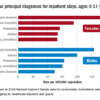PHM Session: Get SMART: Implementation of updated asthma guidelines for pediatric hospitalists
Presenters: Alexander Hogan, MD, MS, Connecticut Children’s Medical Center, Hartford, Conn., Kathryn Kyler, MD, MSc, and Claire Seguin, MD, Children’s Mercy Kansas City, Mo.
This session focused on how pediatric hospitalists can improve the asthma care of patients discharged from hospitalizations by instituting single maintenance and reliever therapy (SMART) regimens. More specifically, this is a single inhaler that includes both an inhaled corticosteroid (ICS) and a long-acting beta-agonist (LABA), which have U.S. Food and Drug Administration-approved formulations as budesonide/formoterol (Symbicort) and mometasone/formoterol (Dulera). SMART regimens for asthma are based on the expert panel report (EPR) update, EPR-4, released by the National Asthma Education and Prevention Program Coordination Committee. The key SMART-specific recommendations discussed by the presenters for patient subsets were:
- For patients over 4 years of age: moderate or severe persistent asthma should be preferentially treated with low- or moderate-dose ICS/formoterol daily and quick-relief therapy, as compared to ICS/LABA plus as-needed (PRN) short-acting beta-agonist (SABA), or high-dose ICS plus PRN SABA.
- For patients over 12 years of age: moderate or severe persistent asthma should be preferentially treated with ICS/formoterol as daily and quick-relief therapy, as compared to higher-dose ICS/LABA daily with PRN SABA.
The target population is patients with moderate to severe persistent asthma older than 4 years with a severe exacerbation in the prior year and uncontrolled ICS/LABA with PRN SABA. Patients taking ICS/salmeterol as maintenance therapy were not to receive ICS/formoterol concurrently. Another clarification was that EPR-4 did not update recommendations for managing children hospitalized with acute asthma exacerbations.
Hospitalists were encouraged to incorporate SMART regimens in asthma action plans at discharge and to reinforce the need to reach out to primary care physicians regarding SMART regimens. Challenges to SMART regimen prescribing include insurance coverage and running out of inhalations before one month due to increased use. A solution to the latter problem was to prescribe two inhalers, one for home and one for school when in actuality, one would be used for maintenance and the other for rescue.
Possibilities for successful implementation of SMART protocols in discharge include clinical pathways, institutional guidelines, asynchronous medical education, and multidisciplinary quality improvement efforts that address care gaps, environments of care, and barriers.
Key Takeaways:
- Pediatric hospitalists can and should initiate SMART regimens for asthma patients being discharged from the hospital setting.
- Sustained implementation of EPR-4 SMART guidelines requires assessment of care gaps, environments, and barriers, and should involve all relevant stakeholders early in the process.
- Dissemination and implementation methods should be used to address barriers to SMART regimen implementation.

Dr. Chang
Dr. Chang is a pediatric and adult hospitalist at Baystate Medical Center and Baystate Children’s Hospital in Springfield, Mass. He is also an associate professor of pediatrics at the University of Massachusetts Medical School Baystate, chief of pediatric hospital medicine, vice-chair for clinical affairs at Baystate Children’s Hospital, and the physician editor of The Hospitalist.

